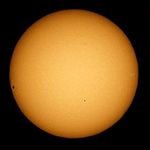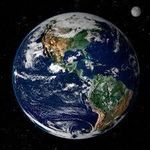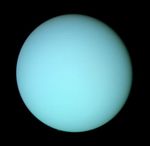Spectacular Science Solar System - Empiribox
←
→
Page content transcription
If your browser does not render page correctly, please read the page content below
Empiribox doesn’t like to limit lessons to staying here on planet Earth; we want to
launch up into space and see what science we can do up there! From the planets to
stars, comets to rockets, we’ll explore it all.
In this activity, your class can make their own solar system, learning about the different
planets and the way they move in our galaxy.
Spectacular Science
Solar SystemSPECTACULAR SCIENCE
Solar System
Our Solar System
At the centre of our solar system is the sun, with all planets and other stars rotating around it. It is actually a
star that happens to be close to us, but it isn’t even a very big star, the largest being Mu Cephi which is 1,500
time bigger than the sun, but much further away so we can’t see it. The sun is the source of energy for nearly
all life on Earth and without it, we would not be able to live.
Below are all the planets in order of how far away from the Sun they are with a few fast facts.
1. Mercury
•35.98 million miles from the sun
•The smallest planet in the solar system
•It rotates around the sun at 31 miles a second
•One year on Mercury (meaning one full rotation of the sun) is just 88 Earth days
•It has a solid core made of metal (mostly iron)
•Its outer crust is made of rock, like Earth
•It has a weak magnetic field due to its size so comets that enter its atmosphere are
not slowed down and crash onto the surface causing craters
2. Venus
•67.24 million miles from the sun
•The closest planet to Earth and about the same size
•The surface is thick with carbon dioxide, meaning it traps all heat from the sun
making the surface temperature 462 degrees Celsius
•You can see it from Earth at dusk or dawn – it appears as a red star
•One day on Venus the same length as 117 Earth days
3. Earth
• 92.96 million miles from the sun
• The only planet known to hold life
• 70% of the surface is water
• The magnetic field makes the atmosphere stronger and thicker
• The atmosphere protects the Earth from comets because it slows them down,
burning them to a tiny rock in the process that won’t damage the surface
• The moon rotates the sun like a natural satellite
info@empiribox.org www.empiribox.org
01835 670 067 Nurturing future ScientistsSPECTACULAR SCIENCE
Solar System
4. Mars
• 141.6 million miles from the sun
• It is home to the tallest mountain in the solar system (that we know) –
Olympus Mons is 13 miles high
• Scientist believe that Mars could hold life as water has been found on its
surface
• One year on Mars is 687 Earth days and the seasons are 2 times as long
• It has two moons; Phobos and Deimos
• While there is no magnetic field on Mars now, scientists believe there was
one about 4 billion years ago
5. Jupiter
• 483.8 million miles from the sun
• It is the largest planet in the solar system
• There are huge storms that last for hundreds of years – at least 300 – that
make the swirling pattern we see
• The atmosphere covering Jupiter is made from hydrogen, helium and
ammonia, similar to the sun
• Scientist believe that if it was any larger it could be a star
• The gas on Jupiter is so thick and dense that they have become liquid
metallic hydrogen on the surface
• It has more than 50 moons
• There are rings of dust and bits of rock that circle Jupiter
6. Saturn
• 890.8 million miles from the sun
• There are 2 rings that circle Saturn made from ice water with a
3,000-mile divide called the Cassini Division
• It is made mostly of hydrogen and nitrogen like Jupiter
• Winds can blow up to 1,600-feet per second – the highest wind on
Earth is 360-feet per second
• One year lasts 10,759 Earth days but because it spins so fast, one
day is only 10 hours and 39 Earth minutes
• You would weigh less on Saturn than you do on Earth
info@empiribox.org www.empiribox.org
01835 670 067 Nurturing future ScientistsSPECTACULAR SCIENCE
Solar System
7. Uranus
• 1.784 billion miles from the sun
• Scientist think it was tipped on it’s side by a collision with another planet
because its poles are in the middle rather than the top and bottom
• It is made of gas similar to Saturn and Jupiter, but methane gas makes it
look blue
• Due to it being on its side, seasons can last for up to 20 years
• There are 11 rings circling Uranus made from dust, rocks and ice
• There are 27 moons, named after Shakespeare characters
8. Neptune
• 2.793 billion miles from the sun
• it has the same blue colour as Uranus, due to methane gas
• scientist believe the core is solid and about the same size as the whole of
planet Earth
• Individual storms are so huge they could engulf Earth in one and have wind
speeds of about 1,200 MPH
• The average temperature is -214 degrees Celsius
• There are 6 rings and 14 moons circling Neptune
• We could fit Earth inside Neptune 60 times
What you will need
Peppercorn – Mercury
Cherry tomato – Venus
Slightly larger cherry tomato - Earth
Blueberry - Mars
Watermelon - Jupiter
Grapefruit - Saturn
Apple - Uranus
Orange - Neptune
One or two rolls of loo paper
Activity – can your class build a to-scale model of the solar system?
Using piece of fruit and loo paper, build a solar system in your classroom or in the playground. You can do
this to a larger or smaller scale, both options are given below.
Make sure you start from the same line for each planet and lie out all the lines of loo roll, placing your fruit
planet at the top of it. This line represents the sun, but there isn’t a fruit large enough to be the sun!
info@empiribox.org www.empiribox.org
01835 670 067 Nurturing future ScientistsSPECTACULAR SCIENCE
Solar System
If you do not have fruit available, you can ask your class to draw each planet and use these instead.
Planet Squares of toilet Squares of toilet
paper needed paper needed
(Short) (Long)
Mercury 1 2
Venus 1.8 3.7
Earth 2.5 5.1
Mars 3.8 7.7
Ceres 7 14
Jupiter 13.2 26.4
Saturn 24.2 48.4
Uranus 48.6 97.3
Neptune 76.3 152.5
info@empiribox.org www.empiribox.org
01835 670 067 Nurturing future ScientistsYou can also read


























































